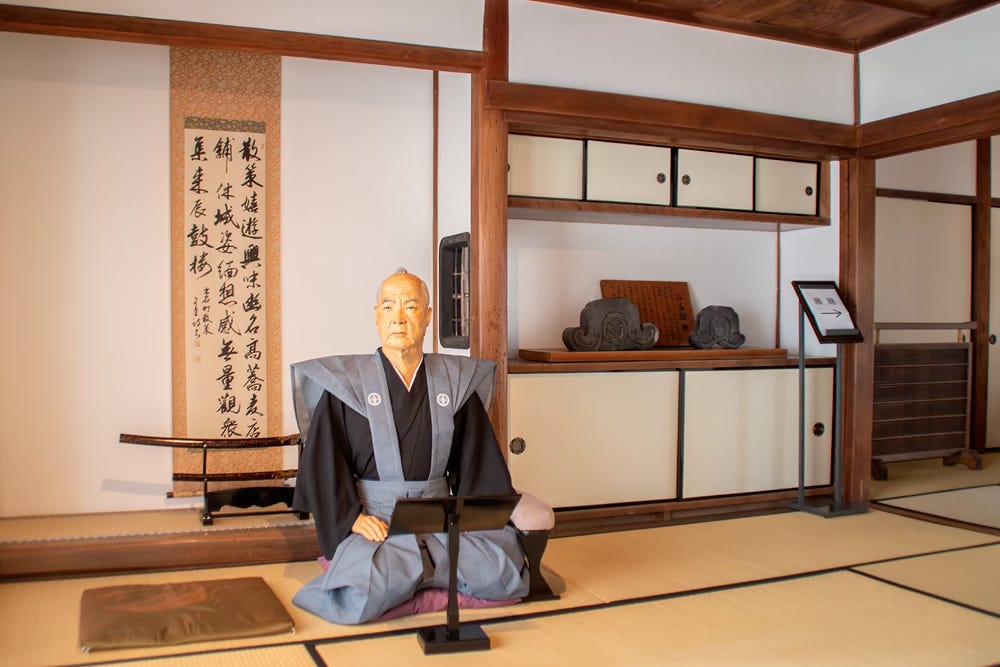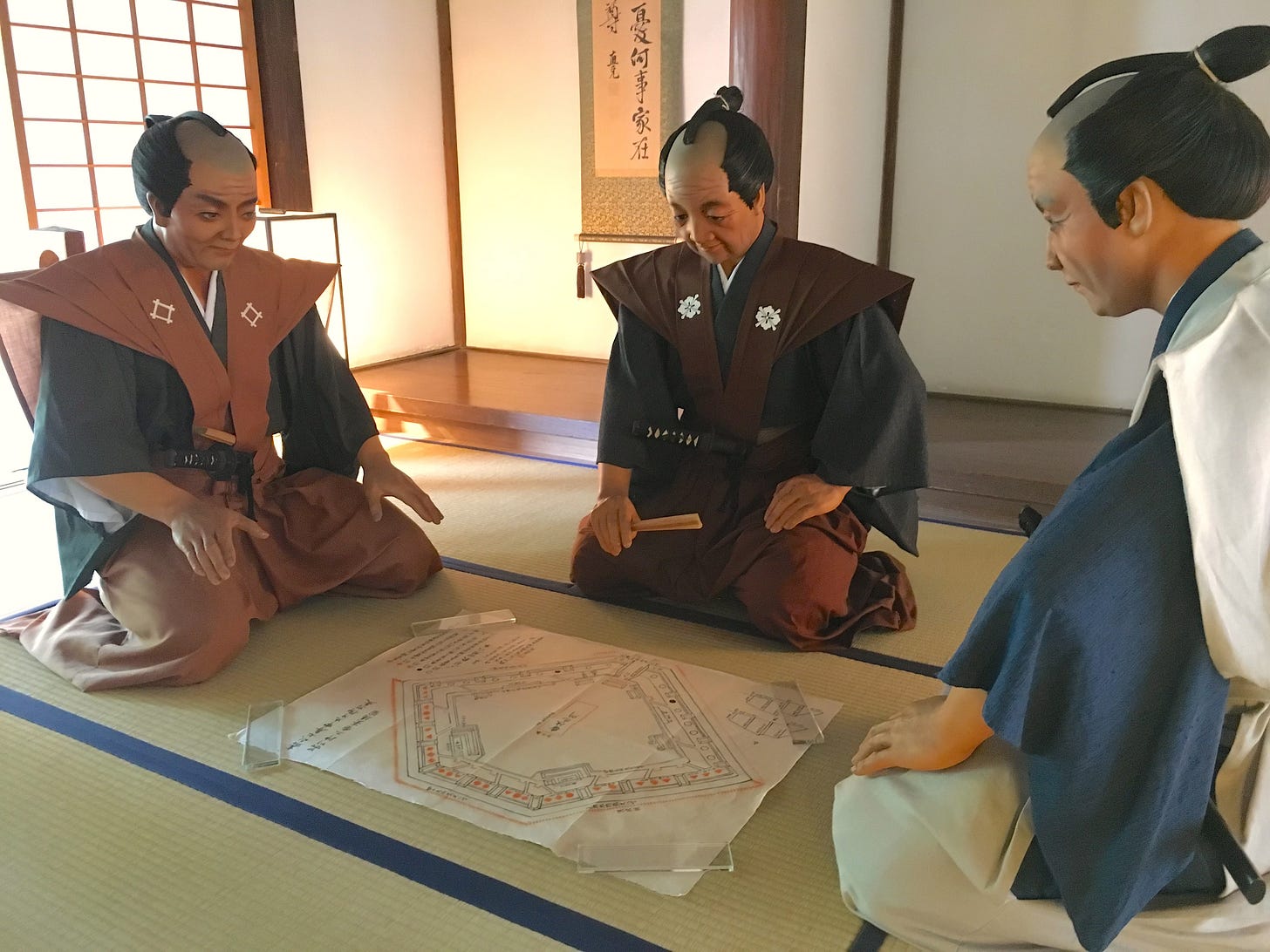Karo, (lit. house elder) were the highest-ranking position among a feudal lord’s samurai retainers. There were usually multiple Karo, or clan elders, and they assisted with managing political and economic issues through consensus. In principle, this official title was used by the highest-ranking vassals of a daimyo. In the case of vassals employed by hatamoto (direct vassals of the shogun) or high-ranking samurai, the position was often called a yonin. The position of Karo developed during the Kamakura period (1185–1333) as samurai society rose to power, but until the Muromachi period, (1336 to 1573) these clan elders and chief advisors were also called toshiyori, otona, shukuro, shitsuji, roju, or kasai. Usually, hereditary vassals and sometimes influential vassals were appointed to these positions.

Duties
Basically, once appointed, a chief retainer would remain in his position until his death, unless he was allowed to retire due to illness or old age or was dismissed.
As there were numerous serving karo, they would rotate the leadership duties on a monthly basis, with the monthly duty karo, known as the Yoban or Tsukiban depending on the domain, making the decisions. Important matters were decided by consensus through regularly held meetings.
Edo Period Karo
In the Edo Period, each feudal domain maintained multiple residences in Edo, and the senior retainers who managed them were called Edo Karo or Edo-tsume. Alternately, karo who remained in the fief were called kuni-garo or zaisho-garo (resident senior retainers). The karo serving a castle lord was referred to as a jodai-garo and was sometimes appointed as a castle caretaker. The jodai-garo was usually of a higher rank than the Edo elder retainer.
When both a jodai-garo and a kuni-garo were in place, the jodai-garo retainer was usually of a higher rank.
Generally, the Karo senior retainers, except for those attached to the Tokugawa branch clans, the Gosanke or the Gosankyo, were vassals of the daimyo and therefore not eligible to have audiences with the Shogun. However, there were exceptions, as many of the elder retainers of the Tokugawa related domains and hereditary daimyo were awarded hatamoto status by the Shogunate, making them eligible to have audiences with the Shogun and be exempt from dismounting at the checkpoints. Some of the clan elders of the Four Great Generals of the Tokugawa (Honda, Ii, Sakai and Sakakibara clans) received not only hatamoto status but also a stipend directly from the Shogunate.
Karo and Toshiyori
Until the early Edo period, many domains had no distinction between the ranks of karo and toshiyori, or local magistrate, and it was common for toshiyori to be the positioned on an equal footing to, or instead of, a karo. In domains with karo, toshiyori, and the similar churo magistrate positions, the karo was often a hereditary position, while the toshiyori and churo positions were awarded to capable individuals.
Alternative Titles for Karo
The terms shusei and sansei were alternative names for karo. In the Yonezawa Domain, the position equivalent to, and in the Sendai Domain, the position of karo was generally called bugyo, or magistrate. In the Choshu Domain, the Karo’s assistant, the temotoyaku, was sometimes also titled karo.
It was not customary to appoint a karo chief retainer to the shogunate’s hatamoto, except in special cases such as highly ranked hatamoto with a stipend of 3,000 koku or more. In the case of a hatamoto with a stipend of between 500 to 3,000 koku, the highest-ranking job title for a retainer was yonin, assistant or servant. There were approximately 250 hatamoto who appointed a karo, and their stipends ranged from 80 to just over 100 koku at most.
Tsuke-garo
Tsuke-garo were chief retainers assigned by the main Tokugawa clan to a branch clan (the Gosanke, being the Owari, Mito and Kii Tokugawa clans) to monitor and supervise it, while reporting to the main clan branch. In some cases, the tsuke-garo received a stipend from both the main and the branch clans, while in others, thetsuke-garo received wages from their assigned branch clan and were gradually absorbed into that branch family.
Some tsuke-garo, such as the Naruse clan of the Owari domain, the Mizuno and the Ando clan of Kii Domain, became castle lords and received official ranks and positions. Although officially tsuke-garo, they were awarded the equivalent rank of daimyo and carried the same status and prestige as daimyo when accompanying their lords on sankin kotai alternate attendance missions.
Because the Gosankyo, (an alternate three branches of the Tokugawa clan established by the eighth Shogun to ostensibly compliment but possibly replace the Gosanke) were treated as family members of the shogun, the position of elder retainer for the Gosankyo was considered the highest position among the shogun's hatamoto alongside the Edo Castle Rusui, caretaker, but it was not uncommon for capable hatamoto with stipends of 3,000 koku or less to be appointed to this position.
Karo-kaku
The position of karo was usually hereditary among fudai (inner) daimyo of the Edo period or rotated among influential vassals. In some cases, samurai of lower positions or status recognized for their abilities could be promoted to positions equivalent to karo, but were recognized as karo-kaku, karo-nami, or karo-retsu.
Eidai and Ichidai Karo
Eidai karo, hereditary or permanent karo had the higher ranking. Ichidai karo referred to non-hereditary karo, promoted based on merit, but the family of an ichidai karo were often promoted. During the Edo period, the number of cases where ichidai karo were appointed increased as the years went by. If a permanent chief retainer was to be punished, the achievements of his ancestors are taken into consideration, and the family was rarely demoted or abolished, however, when a one-generation chief retainer is punished, not only was the head of the family punished, but the clan was often demoted in rank as well.
Karo Clashes
Two or more elders oversaw the administration of the domain through a council system, but factional conflicts often arose over political reforms and the issue of succession. Such conflicts were the root cause of clan feuds and, in the worst cases, even led to the removal of the head of the family.
Privileges and Obligations of the Karo
Karo elders sometimes had a lower residence in addition to their own residence, and generally had their main residences near the castle, which doubled as a defensive facility. They were often allowed to ride in a palanquin, which was not permitted for ordinary vassals.
The elders were responsible for their lord. As the highest practical person in charge of the domain's administration they would often take responsibility in place of their lord. In the worst-case situations, they fulfilled their responsibilities by committing seppuku or by being demoted or beheaded in place of their lord. For example, the karo of the Tohoku domains that lost in the Boshin War of 1868 to 1869 took full responsibility and received punishment for the crimes of the domain, lessening the repercussions on the lords.
Within the Tokugawa clan, the position was called roju. When the Tokugawa clan were still regional lords of Mikawa Province, the Sakai clan of retainers provided a long line of roju. Ishikawa Kazumasa was also promoted to this position. Even after the establishment of the Edo Bakufu, this name continued as the highest-ranking position in the Shogunate, however the temporary position of tairo was placed above roju.
On the death or retirement of their predecessor, creating a vacancy, the next to be awarded the rank of karo was recommended by their lord to the shogunate, and held the rank until their death or retirement. The karo were abolished on the fall of the feudal system after 1868.




